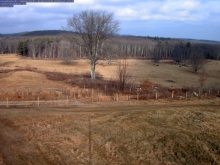You are here
New Cameras Give Glimpse of Harvard Farm

Two research webcams (north, south) now aid the study of seasonal change on the Harvard Farm, Harvard Forest's newest research site and a valuable haven for biodiversity in a region dominated by maturing forests. The cameras and electrical work were supported by a grant from the National Science Foundation's Long-Term Ecological Research program.
The Petersham Country Club, as the land was formerly known, had been managed for nearly a century as a golf course. Without mowing and watering, after purchase by Harvard Forest in 2013, the land quickly became a meadow. Within two years, migratory bobolinks were nesting in overgrown fairways.
A team of scientists from Harvard Forest and elsewhere, together with regional conservation groups and farmers, have developed a plan to study plant and wildlife dynamics in this working landscape where cattle graze, trees are harvested, and hay is cut after nesting season.
The HF Woods Crew fenced the property, and local farmers now graze small herds of cattle, following two experimental grazing methods: traditional and intensive rotational.
In a grid of 27 long-term study plots, scientists track changes in vegetation and soil carbon/nutrients across the property. Additional studies on butterflies, birds, and other species are planned for the coming years.
- Browse Motzkin's report: Biodiversity Conservation on Agricultural Land
- Learn more about the intersection of conservation and agriculture in a report co-authored by HF collaborator Brian Donahue: A New England Food Vision
- Learn more about Harvard Forest plants in the Harvard Forest Flora (2008).

